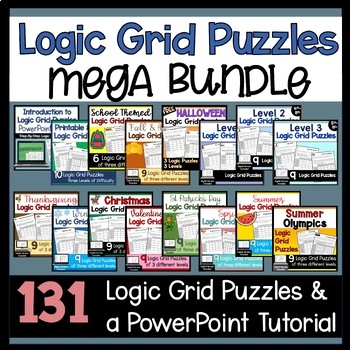Logic Grid Puzzles Mega Bundle
- Zip
- Google Apps™

What educators are saying
Products in this Bundle (16)
showing 1-5 of 16 products
Description
This mega pack of logic grid puzzles are fun for students and encourage critical thinking and the use of deductive reasoning. Logic puzzles require students to determine the relationship between different people, places, and things based on a few clues using logic and reasoning. Save over 35% on these logic puzzles by buying this bundle!
If you're looking for a smaller logic puzzle bundle, I also have three smaller logic puzzle bundles:
- Holiday and Seasonal Logic Puzzle Bundle with 74 logic puzzles
- Four Seasons Logic Puzzle Bundle with 40 logic puzzles
- Holiday Logic Puzzle Bundle with 39 logic puzzles
This resource includes a Logic Puzzle PowerPoint Tutorial and 16 Logic Puzzle Resources with 131 printable puzzles with 121 of them having a digital version:
- Logic Grid Puzzle PowerPoint Tutorial with four level 1 and 2 puzzles
- Logic Grid Puzzles with 10 printable & digital puzzles and 3 levels of difficulty
- Level 1 Logic Puzzles with 9 printable & digital puzzles, all level 1.
- Level 2 Logic Puzzles with 9 printable & digital puzzles, all level 2.
- Level 3 Logic Puzzles with 9 printable & digital puzzles, all level 3.
- School Themed Puzzles with 6 printable puzzles and three levels of difficulty
- Summer Olympics Logic Puzzles with 9 puzzles and three levels of difficulty
Holiday Logic Puzzles:
- Thanksgiving Logic puzzles with 9 printable & digital puzzles of three levels of difficulty.
- Christmas Logic Grid Puzzles with 9 printable & digital puzzles of three levels of difficulty
- Valentine's Day Logic Puzzles with 9 printable & digital puzzles of three levels of difficulty
- St. Patrick's Day Logic Puzzles with 9 printable & digital puzzles of three levels of difficulty
- Halloween Logic Puzzles with 3 free printable & digital logic puzzles of three levels of difficulty
Seasonal Logic Puzzles:
- Fall/Autumn Logic Puzzles with 9 printable puzzles and three levels of difficulty
- Winter Logic Puzzles with 9 printable and digital puzzles of three levels of difficulty
- Spring Logic Puzzles with 9 printable & digital printable puzzles and three levels of difficulty
- Summer Logic Puzzles with 9 printable & digital puzzles and three levels of difficulty
**This bundle includes ALL my logic puzzles. It currently includes 119 logic puzzles from sixteen different resources.
*These logic puzzles are not editable.
Update 11/5/23: I have added 3 more puzzles to the Christmas Logic Puzzle Resource.
Update 10/1/23: I have added 3 more puzzles to the Thanksgiving Day Logic Puzzle Resource.
Update 2/24/23: I have added 3 more puzzles to the St. Patrick's Day Logic Puzzle Resource.
Update 1/20/23: I have added 3 more puzzles to the Valentines Day Logic puzzle resource.
Update 12/14/22: I have added 27 more logic puzzles to this Mega Bundle! These are non-holiday and non-seasonal logic puzzles that are within a level 1 resource, a level 2 resource, and a level 3 resource.





